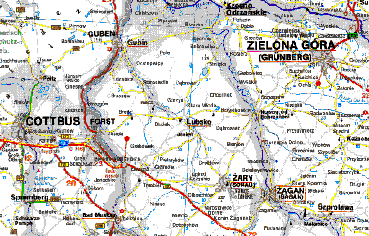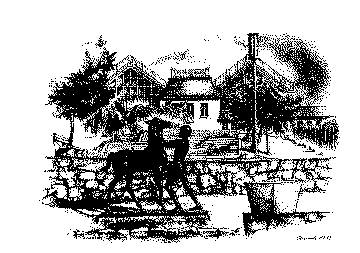Update of the Family History
We wanted to continue writing the family history by adding
new experiences of family members in the historical context.
Therefore we are looking for written memories of life and correspondence
of family members.
Early Bearer of the Name which are not in the Family Tree
Before the Magister Christian there is his father Johannes
Gueinzius, preacher at Kohlo, in the family tree of Dreyhaupt.
The scientist Otto Fischer found him under the name "Quinzius"
in the archives of the church district of Guben/Lausitz (Brandenburg,
Germany), (see his essay about the pastors in the district Forst/Lausitz
in "Herold" 1931, No 1). Sure is that this is the original
form of the name and no spelling mistake as Richard Gueinzius
(1875 - 1939) was thinking. His father was mentioned in the old
family tree of Dreyhaupt:
|
On this page:
Update of the Family Tree
Update of the Family History
Early Bearer of the Name which are
not in the Family Tree
Genealogical Connection to the Weintz
Family
The Origin of the Coat of Arms
|
|
"Johannes Gueinzius, gieng bey der Reformation Lutheri
aus dem Kloster, und ward ein evang. Prediger, soll ehedem Weintz
geheißen haben".
(Johannes Gueinzius was leaving the monastery in the times of
Luther and become a protestant preacher should be named Weintz)
middle old German
Lower Lausitz

This former monk is not detectable otherwise, either in parish
registers, nor in list of students of universities, nor in the
registers of ordination which have been kept from this time.
Only the family tradition of the 18th century knows about him;
how precise in the historical sense is not ascertainable. One
thing is clear: There is a great difference in time between the
- let us call him the "monk preacher" and the preacher
of Kohlo (Koto). The great migration out of the monasteries take
place approximately between 1525 and 1530, the marriage of the
Kohloer took place perhaps not to long before 1591, so that there
is place for another generation in between. But that have not
to be.
The first Johannes could have had so many children and the second
could have been the youngest one. Just as well as the second
Johannes could have married late or Christian (Magister Christian)
could have been the youngest or one of the youngest of his children,
as an explanation for the great difference in time. Anyhow unusual
for that time would be if the second Johannes and Christian would
have been the only sons of their parents.
The second Johannes and Christian have not bee the only bearer
of the name in the Latin version: there were some other Gueinzius
who lived especially in Sorau (Zary) in the 17th century and
were there is no connection to our family tree at the moment.
The reason that they are all named in the Latin way of the names
indicates that their origin has to be derived from that bearer
who has created the Latin version of the name.
Obviously there are no successors of those out of Sorau coming
Gueinzius. Nevertheless there were no successors in this line
found in the last 90 years of the Gueinzius family research.
- Therefore it seems to be fact that all bearer of the name Gueinzius
are descending from Christian August or his son Johann Karl Gottlieb
(1713 - 1790) and therefore from the most famous bearer of our
name: the Magister Christian Gueinzius.
There was a record of the parish register of Langensalza (Thuringia,
Germany)) which gets in a roundabout way to Richard Gueinzius
(1875 - 1939). In this record Mrs. Marie Tilesius (baptized July
22nd 1631 at Langensalza) gets married to (1) Johannes Gueinzius,
born on June 13th 1628, cloth worker, son of the archdeacons
(leader of a college of deaconship) (2) Heinrich Gueinzius, in
Langensalza on June 25th 1650. But we don't know either the place
of birth of Johannes Gueinzius and nor the place where his father
has been archdeacons.
At June 23rd 1674 (3) Hannß George Gweintzius, born and
baptized in Sorau, gets a document from the mayor of the city
of Grünberg (today Zielona Gòra, Poland). On the
basis of testimonials of Grünberg citizen and cloth workers
and certified references from Sorau in this document is attested
that he is "out of an unsuspecting, honest totally undefiled
true marital bed correct pure and conjugal, out of all four ancestor,
pure German free nation and competent impeccable manner, and
nobody's slave", and therefore to all, of those to whom
he will show this letter, best recommended. Also his father and
grandfather are mentioned.
As farther is named: (4) Tobias Gweintzius, citizen, cloth worker
and grinder from Sorau; as grandfather already died: (5) Johann
Gweintzius citizen and cloth worker from Sorau.
Ernst Gueinzius (1884 - 1970) got the original of this document
from a teacher of his daughters and gave it to Richard Gueinzius
(1875 - 1939) the genealogist. It is lost since then.
At August 19th 1689 (6) Hannß George Guinzius, soap boiler
purchases the civil rights in Sorau. In June 1695 (7) Hanß
George Gweinzius in Sorau has to pay tax as a tenant.
1696 (8) Hanß Heinrich Queinzius gets registered as an
inhabitant with 2 Gr. 4 Pf. For his floor.
A list of in Sorau born and studied until 1710 contains a (9)
N. Gueintzius as a cantor in Zinthen (probably Zinten in East
Prussia)
Cloth worker (10) Joh. Gueinzius studies 1635 at Frankfurt/O..
Gotthold Gueinzius (1913 - 1986) suppose identity for 6 and 7,
perhaps for 3 too.
1st Hypothesis:
The listed persons are brothers of Johannes Gueinzius,
father of the Magister Christian (1592 - 1560) and their followers.
|
Homepage of the city of Zilona Góra
|
Genealogical connection to the Weintz Family
In the German white pages there are over one hundred entries
about the name Weintz. It is possible that the "monks preacher"
Johannes in the times of Luther has chosen the old kind of the
family name and transferred it into the Latin form. The fact
that even the older form Queintz was used in later times gives
reasons to this theory. That would mean that the brothers and
sisters or other relatives depending on the linguistic progress
may have named Weintz and reproduced themselves with this name.
It is a family Weintz resident since the 16th century at the
municipality Erpolzheim / Rhineland-Palatinate.
2nd Hypothesis:
There is an genealogical connection to the Weintz
family which results out of the times before the monks preacher
at the times of Luther.
|
Families of the city of Erpolzheim / Rhineland-Palatinate |
The Origin of the Coat of Arms
There is no acknowledge about the origin of the coat of arms.
Ernst Gueinzius (1884 - 1970) writes about the coat of arms in
his memories of life: "the grapevine in the coat of arms
points perhaps at the wine city Grünberg (today Zielona
Gòra, Poland). The wine of Grünberg was famous for
the acid "Dreimännerwein!" (three mans wine).
Indeed visitors of the city of Grünberg are confirming that
there are a green vineyard in the middle of the city.
In a tourist information "Traveling on both sides of Oder
and Neisse", given from the Wojewodschaft Zielona Góra,
the local tourist association Frankfurt/Oder and the rural districts
ORING Spree and Spree-Neisse are called it under selected monuments
(1997):
Zielona Góra - the capital of the Wojewodschaft reclines
between picturesque hills. The beginning of this city goes back
to the 13th century. The first note comes from year 1222; 1323
received city right Zielona Góra. Already at the beginning
of the 14th century, vinestocks were built on here and the city
was confessed by wine market. A report of the "old woman
times" is the sited on a hill, the wine park and there the
wine house surrounded by vines, today a restaurant in the palm
house. The most interesting sights are found at the old market.
Between buildings from the 18th and 19th century stands, the
city hall built initially of wood, 1582 burned. The new city
hall became 1652 - 79 in the classicist pin list uplifted and
one further enlarged later. The seat of the city government is
here today. The very high one, tower covered baroque era helmet
three-storeyed with one, surmounts the city hall and the alto
urban development. Near the city hall, that stands so-called
"starvation or swimming tower"- the balance amount
of the former city gate. The oldest monument of the city is the
St. Hedwig cathedral, a monumental building from the 14th century.
Sight value is also the early evangelic church which was built
in the 18th century. The rest of the city fixing that was constructed
in the 14th century, in part from stone and in the upper part
of brick, stands near the old market. The chapel "in the
wine garden" who was built at the beginning of the 14th
century is well also received.

Restaurant in the palm house in the wine park
source: http://www.zgora.pl/zgora/zgora.cgi?miejsca+pol
3rd Hypothesis:
The heraldic figure is connected to the city of Grünberg
and was already in use by the family before the "monks preacher",
and perhaps in use by the family Weintz, too.
|
 |


